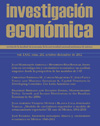CAPITAL STRUCTURES IN DEVELOPING COUNTRIES: THE LATIN AMERICAN CASE
Main Article Content
Abstract
Rajan and Zingales (1995) find that tangibility, growth opportunity, size and performance are the four common determinants for explaining capital structure across G-7 countries. In this study, we consider a sample of 590 firms from Argentina, Chile, Mexico, Peru and the United States (U.S.), to analyze whether the four common determinants also explain the capital structure in the Latin American countries. Moreover, we use a different sample of companies and a large number of years for U.S. firms and we find similar results to those reported by Rajan and Zingales (1995) more than a decade ago.
As expected, we report similar results for Chilean firms as the updated results for U.S. firms. The capital structure of Chilean firms is: positively related to tangible assets; negatively related to growth opportunities; positively related to size and negatively related to performance. This is not only true for book leverage but also for market leverage. The rest of Latin American countries show mixed results. In any case, we find two or three determinants to be statistically significant. However, those determinants are not the same when we use book leverage versus market leverage.Article Details
Citas en Dimensions Service
Authors who publish in this journal agree to the following conditions:
a) The authors retain the copy rights (copyright) and give the journal the right of first publication, with the work also under the Creative Commons Attribution License that allows third parties to use what is published as long as they refer to the author or authors of the article. work and its publication in this journal.
b) The authors are free to make other contractual agreements for the non-exclusive distribution of the article they publish in this journal (such as including it in an institutional collection or publishing it in a book), provided that they clearly indicate the original publication of the work in this journal.


